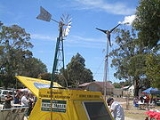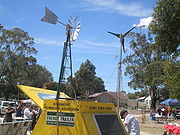
Green building in Australia
Encyclopedia
The Green Building Council of Australia (GBCA) has developed a green building
standard known as Green Star
, with the first Green Star rating in Australia awarded to 8 Brindabella Circuit at Canberra Airport in 2004.
EER: Energy Efficiency Rating launched in 1996 and in Australia is a system ranging from 0-10 stars and mandatory for buildings in the Australian Capital Territory (ACT) region
The Green Star environmental rating tools for buildings benchmark the potential of buildings based on nine environmental impact categories: Management; Indoor Environment Quality; Energy; Transport; Water; Materials; Land Use & Ecology; Emissions and Innovation.
The National Australian Built Environment Rating System (NABERS), is a government initiative to measure and compare the environmental performance of Australian buildings. The NABERS ratings for office buildings include: Energy; Water; Waste and Indoor environment.
A rating for transport is also in development. Together, these ratings can provide a comprehensive picture of the sustainability performance of office buildings and tenancies. Ratings are also available for homes and hotels. Retail and hospital ratings will be launched later this year.
, the refurbished facility of Australian Ethical Investment
Ltd. The total cost of the renovation was $1.7 million, and produced an estimated 75% reductions in carbon dioxide emissions, 75% reduction in water usage, and used over 80% recycled materials. The architects were Collard Clarke Jackson Canberra, architectural work done by Kevin Miller, interior design by Katy Mutton.
(Building Sustainability Index) requires that all new residential developments to reduce water consumption by 40%, and CO2 emissions by 40% for detached dwellings and between 20 and 30% for multi unit dwellings compared to an average baseline. The online system provides designers with a mathematical model of the development that considered the interactions between the energy and water systems of the whole, drawing on climatic and normalised rainfall data for individual locations.
 Melbourne
Melbourne
has a rapidly growing environmental consciousness, many government subsidies and rebates are available for water tanks, water efficient products (such as shower heads) and solar hot water systems.
, Western Australia
, there are at least three different projects that incorporate the principles of green building. The Office development located in Murray Street, West Perth being designed by Eco Design Consultant in collaboration with Troppo Architects is one of them. The other two are mixed development along Wellington Street, in the city centre. Guidelines for building developments in each project are outlined in the bylaws and the Green Building Council of Australia.
Green building
Green building refers to a structure and using process that is environmentally responsible and resource-efficient throughout a building's life-cycle: from siting to design, construction, operation, maintenance, renovation, and demolition...
standard known as Green Star
Green Star (Australia)
Green Star is a voluntary environmental rating system for buildings in Australia. It was launched in 2003 by the Green Building Council of Australia....
, with the first Green Star rating in Australia awarded to 8 Brindabella Circuit at Canberra Airport in 2004.
EER: Energy Efficiency Rating launched in 1996 and in Australia is a system ranging from 0-10 stars and mandatory for buildings in the Australian Capital Territory (ACT) region
The Green Star environmental rating tools for buildings benchmark the potential of buildings based on nine environmental impact categories: Management; Indoor Environment Quality; Energy; Transport; Water; Materials; Land Use & Ecology; Emissions and Innovation.
The National Australian Built Environment Rating System (NABERS), is a government initiative to measure and compare the environmental performance of Australian buildings. The NABERS ratings for office buildings include: Energy; Water; Waste and Indoor environment.
A rating for transport is also in development. Together, these ratings can provide a comprehensive picture of the sustainability performance of office buildings and tenancies. Ratings are also available for homes and hotels. Retail and hospital ratings will be launched later this year.
History
The Green Building Council of Australia has certified more than 170 buildings around Australia, among them the 6 Green Star certification of Trevor Pearcey House in CanberraCanberra
Canberra is the capital city of Australia. With a population of over 345,000, it is Australia's largest inland city and the eighth-largest city overall. The city is located at the northern end of the Australian Capital Territory , south-west of Sydney, and north-east of Melbourne...
, the refurbished facility of Australian Ethical Investment
Australian Ethical Investment
Australian Ethical Investment Limited is an Australian owned company established in 1986 for the purpose of environmental and socially responsible investing...
Ltd. The total cost of the renovation was $1.7 million, and produced an estimated 75% reductions in carbon dioxide emissions, 75% reduction in water usage, and used over 80% recycled materials. The architects were Collard Clarke Jackson Canberra, architectural work done by Kevin Miller, interior design by Katy Mutton.
New South Wales
In NSW, an on-line assessment system called BASIXBASIX
BASIX or Building Sustainability Index is a scheme introduced by the government of New South Wales, Australia in 2004 to regulate the energy efficiency of residential buildings. It offers an online assessment tool for rating the expected performance of any residential development in terms of water...
(Building Sustainability Index) requires that all new residential developments to reduce water consumption by 40%, and CO2 emissions by 40% for detached dwellings and between 20 and 30% for multi unit dwellings compared to an average baseline. The online system provides designers with a mathematical model of the development that considered the interactions between the energy and water systems of the whole, drawing on climatic and normalised rainfall data for individual locations.
South Australia
Guidelines for building developments in each project are outlined in the bylaws. The bylaws include various permutations of grey water reuse, reuse of stormwater, capture of rainwater, use of solar panels for electricity and hotwater, solar passive building design and community gardens and landscaping.Victoria

Melbourne
Melbourne is the capital and most populous city in the state of Victoria, and the second most populous city in Australia. The Melbourne City Centre is the hub of the greater metropolitan area and the Census statistical division—of which "Melbourne" is the common name. As of June 2009, the greater...
has a rapidly growing environmental consciousness, many government subsidies and rebates are available for water tanks, water efficient products (such as shower heads) and solar hot water systems.
Western Australia
In PerthPerth, Western Australia
Perth is the capital and largest city of the Australian state of Western Australia and the fourth most populous city in Australia. The Perth metropolitan area has an estimated population of almost 1,700,000....
, Western Australia
Western Australia
Western Australia is a state of Australia, occupying the entire western third of the Australian continent. It is bounded by the Indian Ocean to the north and west, the Great Australian Bight and Indian Ocean to the south, the Northern Territory to the north-east and South Australia to the south-east...
, there are at least three different projects that incorporate the principles of green building. The Office development located in Murray Street, West Perth being designed by Eco Design Consultant in collaboration with Troppo Architects is one of them. The other two are mixed development along Wellington Street, in the city centre. Guidelines for building developments in each project are outlined in the bylaws and the Green Building Council of Australia.
Further reading
- DETR, (2000). “Building a better quality of life: A Strategy for more Sustainable Construction.” Department of Environment, Transport & Regions, UK.

